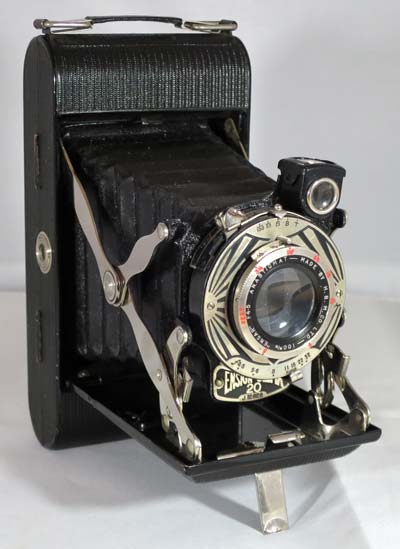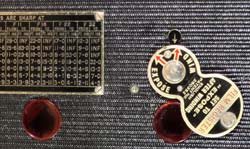Ensign Selfix 20 1936
Specification

| Manufacturer | : | Houghton-Butcher |
|---|---|---|
| Produced | : | 1936 - 1937 |
| Classification | : | Medium Format |
| Body Type | : | Folding Bed |
| Bellows Deployment | : | Self Erecting |
| Construction | : | Metal |
| Film Type | : | 120 |
| Film Width | : | 62mm |
| Image Size | : | 2¼ x 3¼ or 2¼ x 1⅝ |
| No. of Images | : | 8/16 |
| Lens Type | : | Ensar Anastigmat |
| Focus Type | : | Variable |
| Focal Length | : | 100mm |
| Focal Range | : | 3¼ft - inf. |
| Aperture Type | : | Iris |
| Apertures | : | f/4.5 - f/32 |
| Shutter Type | : | leaf |
| Shutter Speeds | : | T, B, I(1/25, 1/50, 1/100) |
| Size Open (w x h x d) | : | 85 x 153 x 124 mm |
| Size Closed (w x h x d) | : | 85 x 153 x 38 mm |
| Weight | : | 635g |
Art Deco Credentials
![]()
![]()
![]()
![]()
Significant: Pronounced and self evident
- Produced during the main Art Deco period.
- Sunburst markings on shutter bezel.
- Chrome used on decorative struts.
- Ribbed pattern on body material.
- Chrome detailing
- Name plate with Art Deco lettering

Description
This camera has a metal body. Some versions have zigzag lines on the shutter bezel. It takes 8 (2¼ x 3¼ inch) or 16 (2¼ x 1⅝ inch) exposures. It normally comes with a mask for the film plane to produce the smaller images but these are easily lost and are often missing. Likewise the viewer on the body has a mask that can be swiveled into place to allow the photographer to frame the smaller images. The camera has two red windows. When 16 smaller images are being used, the film is advanced until the image number is seen in the first red window, and for the next frame, the film is advanced until the same image number appears in the second window.

It uses front cell focussing varying from to 3½ feet to infinity. There is a depth of field chart on the back. It has a brilliant finder that can be rotated for portrait and landscape views. It is self-erecting using a rather attractive chrome strut system. The shutter mechanism is not coupled to the body. There is a threaded bracket to attach a shutter release cable. There are tripod connector holes for both portrait and landscape.
How to Use
Find the manual here. This camera takes 120 film which is readily available. The second red window should be covered in black tape except when advancing the film.
Shutter speeds available are 1/25s, 1/50s and 1/100s.
If you don't want to bother with an exposure meter, follow the guide shown. It is based on the 'Sunny 16' rule. Film is so forgiving and will produce acceptable results even when overexposed by 2 or 3 stops or underexposed by 1 stop.
Remember that the exposure guide in the camera user manual may not be helpful as it is based on the use of old film with a low ISO value.
The tables assume that the sun is at least 30 degrees above the horizon - that's 10am - 5pm on a summer's day in the UK.
If you are not sure about the light level, err on the side of overexposure - i.e. assume the smaller f number.
Where there is a choice, a larger f number will give a larger depth of field.
For the slower speeds, you may need a tripod to stop blur through shake.
Using ISO 100/125 film
| Weather Conditions | Shadow Detail | Shutter Speed (s) | ||
|---|---|---|---|---|
| 1/25 | 1/50 | 1/100 | ||
 Sunny SunnySnow/Sand | Dark with sharp edges | - | f/32 | f/22 |
 Sunny Sunny | Distinct | f/32 | f/22 | f/16 |
 Slight Overcast Slight Overcast | Soft around edges | f/22 | f/16 | f/11 |
 Overcast Overcast | Barely visible | f/16 | f/11 | f/8 |
 Heavy Overcast Heavy Overcast | None | f/11 | f/8 | f/5.6 |
 Open Shade Open Shade/Sunset | None | f/8 | f/5.6 | f/4.5 |